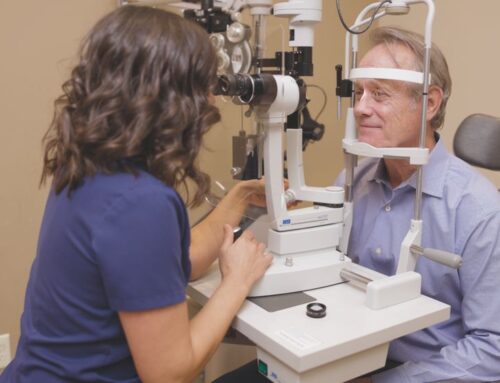Cataracts are extremely common, and cataract surgery is one of the safest, most successful procedures performed worldwide. When it comes to advanced intraocular lenses, the PanOptix® trifocal IOL has one of the highest satisfaction rates on record, over 99% of patients in the pivotal study said they would choose the same lens again. That kind of outcome gives many patients confidence, but it still leaves one big question:
“Will my vision feel strange at first? How long does it take to fully adjust?”
If you’re considering PanOptix or preparing for surgery, it’s helpful to know what to expect. PanOptix is a trifocal intraocular lens designed to give sharp vision at near, intermediate, and distance ranges,often reducing or eliminating the need for glasses. But like any premium lens, it comes with a short adjustment period while the brain adapts.
Below, we’ll walk through what PanOptix lenses are, why they feel different at first, a realistic recovery timeline, what symptoms are normal, how to speed up adaptation, and when to call your surgeon.
What Are PanOptix Lenses and Why Do They Feel Different at First?
PanOptix lenses function differently from monofocal intraocular lenses (standard cataract lenses). Instead of providing a clear vision at just one distance, PanOptix splits incoming light into three focal zones so you can see at:
- Distance (driving, TV)
- Intermediate (computer distance)
- Near (reading, phone)
This multifocal design is what reduces dependence on glasses,but it also explains why your vision may feel “busy,” slightly unusual, or overly bright at first.
Neuroadaptation: Your Brain Has to Learn the New Vision System
Your eyes and brain have spent your entire life focusing in a certain way. Once PanOptix lenses are in place, your brain needs time to:
- Filter out extra light artifacts
- Select the correct focal zone
- Blend vision smoothly between distances
This process is known as neuroadaptation, and it naturally improves over time.
Benefits Patients Notice as Adaptation Occurs
- Sharper distance vision for driving
- Clearer intermediate vision for computer and daily tasks
- Better near vision for reading
- Less dependence on glasses overall
What Is the Typical Recovery Timeline After PanOptix Lens Surgery?
Adjusting to your new PanOptix lenses is a gradual process, and most patients want to know: How long does it take to adjust to PanOptix lenses? While everyone heals differently, the recovery timeline is generally predictable.
First 24 – 48 Hours
During the first couple of days, it’s normal to experience:
- Mild blurry vision
- Light sensitivity
- Watery or irritated eyes
Most patients already notice an improvement in clarity compared to before surgery as the initial fogginess settles. Follow your prescribed eye drop schedule carefully and wear your protective eye shield exactly as directed.
First Week
Your vision should sharpen steadily each day. During this week:
- Screens and reading often feel easier
- Small print may fluctuate
- Halos, starbursts, or glare may appear around lights
These light rings are extremely common with multifocal and trifocal IOLs in the early stages.
First Month
By the end of the first month:
- Many patients feel comfortable at all three distances
- Every day tasks feel more natural
- The brain begins filtering out distracting extra light
This is when many people start saying, “My vision is really settling in now.”
Three to Six Months
Neuroadaptation continues, and most patients report:
- Halos and glare becoming less noticeable
- Night driving feeling “normal” again
- Stable, consistent vision across all distances
For many, the 3 – 6 month window is when PanOptix feels completely natural.
Will I See Halos, Glare, or Other Visual Disturbances?

Are halos normal after PanOptix lens surgery? Halos, starbursts, or glare, especially around headlights or street lamps, are common during the early adaptation period. This occurs because trifocal IOLs split light to produce more than one focal point.
In studies of trifocal lenses, these symptoms typically decrease significantly over the first 1–3 months, and may continue to improve for up to 6 months.
What’s Usually Normal
- Mild halos at night
- Temporary light sensitivity
- Slight fluctuations in near vision
- Occasional “ghosting” during the first few weeks
What’s Not Normal
- Vision getting cloudier instead of clearer
- Light sensitivity increasing after the first day
- Colors looking unusually dull
- Pressure or fullness in the eye
- Halos or glare worsening over time
How Can I Help My Eyes Adjust to PanOptix Lenses Faster?
A smooth recovery depends on giving both your eyes and your brain the right environment to adapt.
- Follow your drop schedule faithfully to control inflammation.
- Protect your eyes, avoid rubbing, wear shields at night, and use sunglasses outdoors.
- Practice focusing at all distances:
- Read in short, comfortable intervals
- Use your computer in good lighting
- While parked, practice shifting focus from the dashboard to a distance
- Use proper lighting when reading or doing close tasks early on.
- Take breaks if your eyes feel tired.
- Keep your follow-up visits so your surgeon can ensure everything is healing properly.
When Should I Call My Cataract Surgeon About My PanOptix Lenses?
Contact your surgeon immediately if you experience:
- A sudden drop in vision after initial improvement
- Severe eye pain, redness, or discharge
- New floaters, flashes, or a curtain-like shadow
- Halos or glare that are severe and not improving after the early months
- Any symptom where “something just feels wrong”
Early communication helps protect long-term results.
What Patients Are Saying About PanOptix Lenses
The PanOptix trifocal IOL has some of the highest satisfaction rates among cataract patients. More than 99% of participants in the pivotal clinical study said they would choose the same lens again.
Eye Care Professionals has been serving the Reno community for over 55 years and offers advanced implantable lens technologies, including PanOptix and PanOptix Pro.
Many patients share that they now enjoy:
- Clear vision for driving and outdoor activities
- Easier reading and device use
- Little or no reliance on glasses
- Confidence knowing what to expect at each stage of recovery
Where to Get PanOptix Lenses in Reno, NV
Deciding whether the PanOptix lens is right for you depends on your lifestyle, visual goals, and overall eye health. While many patients enjoy greater freedom from glasses, it’s important to have a detailed evaluation with an eye care specialist who understands how different lens options perform.
If you’re considering the PanOptix lens or want to learn more about cataract surgery options, explore our advanced implantable lenses and schedule an appointment at Reno Eye Care Professionals. Our team will guide you in understanding which intraocular lens best suits your needs and provide personalized guidance throughout the process.
With the right treatment plan, a clearer, more vibrant vision is closer than you think.











